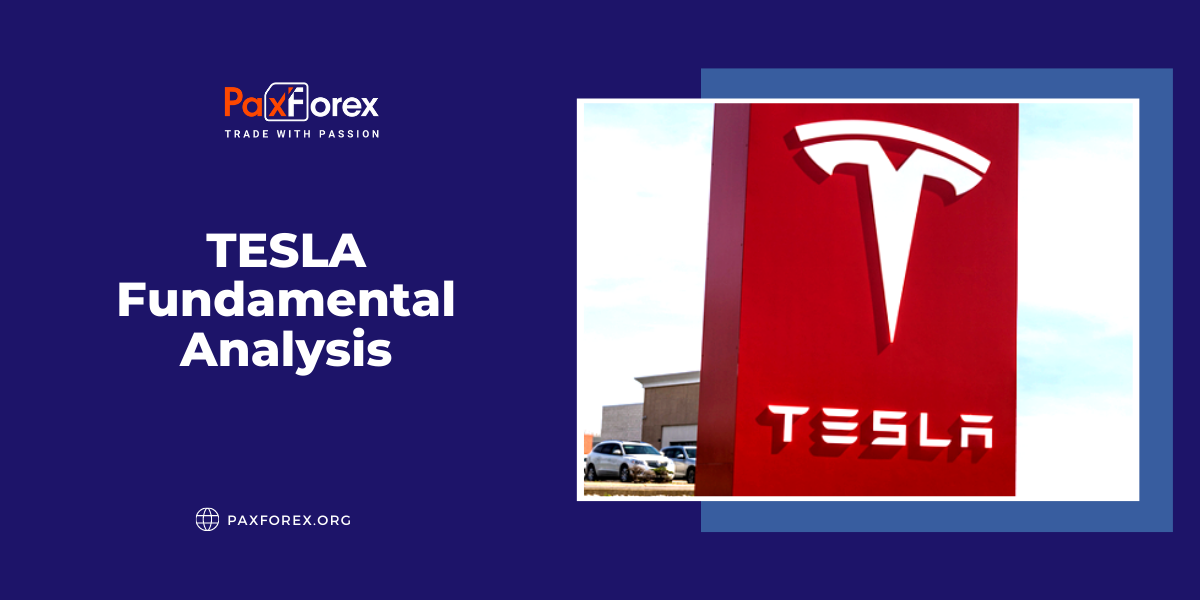
Source: PaxForex Premium Analytics Portal, Fundamental Insight
On March 28, Tesla made headlines when management announced at its annual shareholder meeting that it intended to seek shareholder approval for a stock split. Although details were not disclosed, the last time the split took place in 2020, it happened on a 5-to-1 basis. Since Tesla stock trades at around $1,000 a share, a similar split would mean that each share would be worth around $200.
This arrangement works by reducing the value of each share by one-fifth and instantly paying a dividend of four additional shares so that stockholders get everything. The last split caused an epic 80% increase in the share price between the announcement and the actual split in August 2020.
Those who bought shares before the announcement and held out until the split got an incredible 80% return in less than a month. However, since August 31, 2020, the stock has risen another 120%, including the price correction that occurred immediately after the last split ended.
The split may have been a positive catalyst in the short term, but it was the business performance that drove the stock further up over the past year and a half. Given Tesla's positive business direction, investors should be excited about its execution and plans, not the upcoming split.
Over the course of its existence, Tesla has been questioned by many people. Regardless of how you feel about the company's CEO and founder or his business practices, Tesla has taken electric vehicles (EVs) to the forefront. In the fourth quarter of 2021, Tesla delivered 308,600 electric vehicles. That's not too bad compared to the 27,410 Mustang Mach-Es delivered by Ford Motor Company for all of 2021.
For now, Tesla is the clear leader in the U.S. electric car race. With the long-awaited Cybertruck likely to be launched in 2022, Tesla will have another catalyst to boost sales, although it will appear later than Rivian and Ford.
While Tesla dominates the domestic market, it has much tougher competition on the global stage.
Even though Tesla is still the leader, it has some capable competitors overseas, which makes sense, since electric cars are not an industry in which everyone wins. At its current capacity, Tesla can produce just over 1 million cars a year at its plants in California and Shanghai. However, the company has plants in Berlin and Texas that will soon be up and running, allowing it to increase capacity as market demand expands. Although company executives don't give specific numbers, they expect 50% annual growth in vehicle shipments over a "multi-year horizon."
With increased production, investors should be encouraged by Tesla's expansion plans.
Tesla has come a long way since it nearly declared bankruptcy on Christmas Eve 2008. As of Dec. 31, the company had more than $17.6 billion in cash on its balance sheet and only $5.2 billion in debt. Overall, Tesla produced $5 billion in free cash flow in 2021, showing its ability to survive without outside financing.
Many bears said that Tesla could never be profitable and that it supported its business by selling energy loans, but it turned out they were wrong. Tesla got only $314 million from loans in the fourth quarter, down 22% from last year. It also earned a 14.7% operating margin under generally accepted accounting principles (GAAP), nearly three times the 5.4% operating margin of Ford and 4.5% operating margin of GM. This increase in operating efficiency boosted Tesla's earnings per share (EPS) by 754% to $2.05 in Q4. Tesla's business is profitable and is rapidly increasing quarterly revenue by 71% year-over-year; both factors inflict a crushing defeat on those who are dead set against Tesla stock.
One of the arguments in favor of Tesla bears is the extreme valuation of the stock. Tesla stock trades at an exorbitantly high price-to-earnings (P/E) ratio of 219 and a free cash flow of 347. Considering that Ford and GM are trading at P/E ratios of 3.7 and 6.4, respectively, Tesla's stock valuation seems rather inflated.
However, Tesla is not a legacy automaker. Its direct-to-consumer business model gives it a margin advantage, and Tesla has other ambitions in solar roofs and batteries. While Musk is running the company, it's unclear which venture Tesla will go into next. Some see it as a bad characteristic, while others support the idea.
Regardless, business valuation is a major investment risk at this time. Buying even a great business at the wrong price can lead to suboptimal investment returns.
As Tesla's rate of return steadily increases through 2021, and its revenue also increases, the stock's valuation will decline over time.
With a great business in a growing market, Tesla is a great investment. Because of the high valuation, it may be wise to get into the stock little by little over time. Tesla stock is volatile and has experienced several corrections on the way to its current high valuation. And if the stock reacts the way it did in 2020, waiting may not be the best decision for investors. While the stock is unlikely to replicate the 80 percent takeoff it showed in 2020, it could still continue to rise.
As long as the price is above the 1000.00 level, follow the recommendations below:
- Time frame: D1
- Recommendation: long position
- Entry point: 1089.00
- Take Profit 1: 1151.00
- Take Profit 2: 1251.00
Alternative scenario:
If the level of 1000.00 is broken-down, follow the recommendations below:
- Time frame: D1
- Recommendation: short position
- Entry point: 1000.00
- Take Profit 1: 891.00
- Take Profit 2: 785.00













